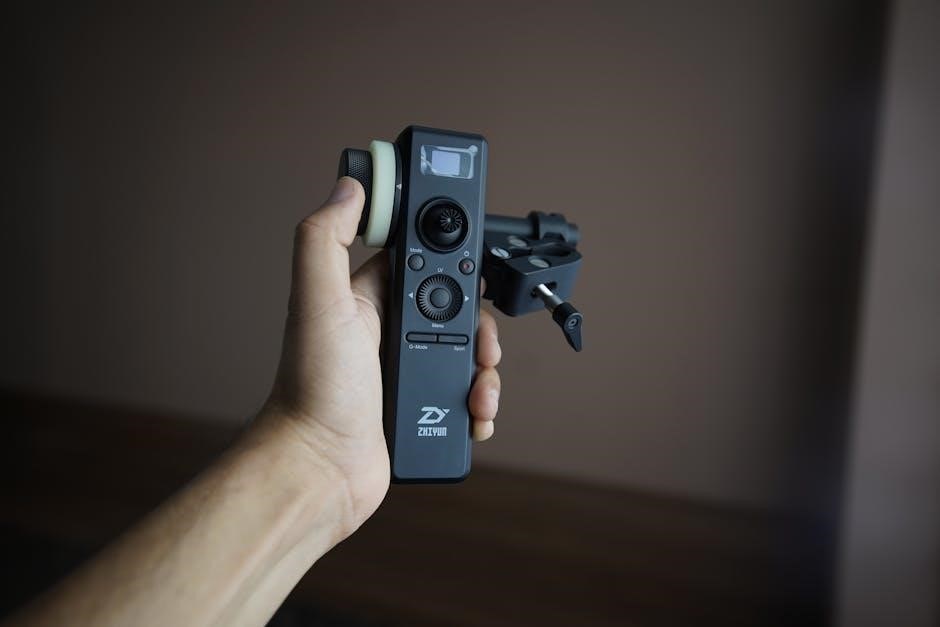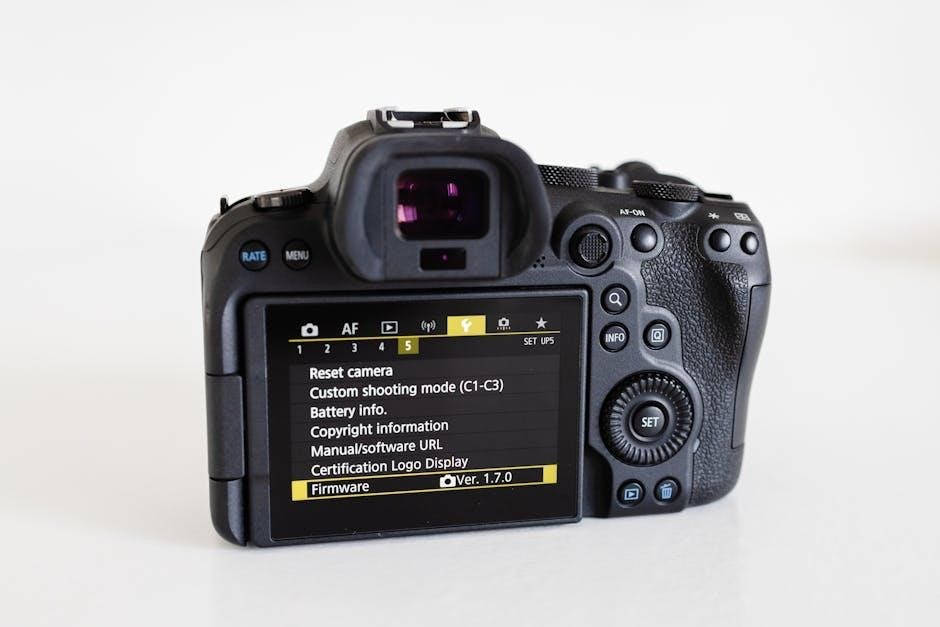dixell controller manual pdf
- by stephany

Dixell controllers are advanced electronic devices designed for precise temperature control in various applications. They offer flexibility, efficiency, and user-friendly interfaces, making them ideal for industrial and commercial settings.
1.1 Overview of Dixell Controllers
Dixell controllers are advanced electronic devices designed for precise temperature control in refrigeration, heating, and cooling systems. They offer a range of models, including the XR100, XT, XC, and Prime series, catering to different applications. These controllers are known for their efficiency, reliability, and user-friendly interfaces. The manual provides detailed instructions for installation, operation, and programming, ensuring optimal performance. With features like customizable settings and integration capabilities, Dixell controllers are versatile tools for various industrial and commercial needs, supported by comprehensive documentation.
1.2 Importance of the Dixell Controller Manual
The Dixell controller manual is an essential resource for users, providing comprehensive guidance on installation, operation, and troubleshooting. It includes detailed programming flow charts, parameter lists, and step-by-step instructions tailored for specific models like the XR100, XT, and XC series. The manual ensures proper setup and maintenance, maximizing the controller’s efficiency and lifespan. By following the manual, users can optimize performance, avoid common issues, and comply with safety standards, making it indispensable for both professionals and DIY enthusiasts working with Dixell controllers.

Installation and Setup
The Dixell controller manual provides a detailed guide for installation and setup, ensuring proper configuration and functionality. It outlines pre-installation checks and step-by-step instructions for various models.
2.1 Pre-Installation Checks
Before installing a Dixell controller, ensure compatibility with your system. Verify power supply requirements, communication protocols, and environmental conditions. Check for any firmware updates and ensure all components are included. Review the manual for model-specific instructions to avoid installation errors. Proper preparation ensures smooth operation and optimal performance. Always follow safety guidelines to prevent damage or hazards. A thorough pre-installation check guarantees a successful setup and minimizes potential issues down the line.
2.2 Step-by-Step Installation Guide
Begin by physically installing the Dixell controller in a secure, accessible location. Connect the power supply, ensuring it matches the controller’s voltage requirements. Next, link sensors and output devices according to the wiring diagram in the manual. Mount the controller firmly to prevent vibration issues. Connect communication cables for networking, if required. Power on the device and verify LED indicators for proper operation. Follow the manual’s specific instructions for your model to ensure a safe and correct installation process.
2.3 Initial Setup and Configuration
After installation, power on the Dixell controller and follow the on-screen prompts. Set the language, date, and time. Navigate to the configuration menu to define basic settings like temperature units, alarm thresholds, and output types. Input sensor calibration values if required. Configure communication settings for remote monitoring or integration with other systems. Save all changes and test the controller’s response to ensure proper functionality. Refer to the manual for model-specific configuration steps to complete the setup accurately.

Operating the Dixell Controller
Master the Dixell controller’s intuitive interface, navigate through menus, and access real-time data. Set operating parameters, monitor performance, and use alarms for notifications to ensure efficient operation.
3.1 Understanding the Controller Interface
The Dixell controller interface is designed for ease of use, featuring a clear LCD display and intuitive navigation. Users can access menus, adjust settings, and view real-time data. The interface includes customizable screens, allowing operators to prioritize frequently used functions. Buttons and scroll navigation enable seamless interaction. Status indicators provide instant feedback on system performance. Understanding the layout and functionality ensures efficient operation and quick access to critical controls, making it user-friendly for both novice and experienced operators.
3.2 Basic Operations and Functions
The Dixell controller performs essential functions such as starting and stopping operations, setting temperature parameters, and monitoring system status. Users can navigate through menus to adjust settings like cooling, heating, and fan speeds. The controller also displays real-time data, including current temperature, humidity, and system faults. Basic functions are accessed via the interface, allowing operators to perform routine tasks efficiently. Understanding these operations ensures smooth control of connected equipment, making it essential for daily management and maintenance of the system.
3.3 Advanced Operating Features
The Dixell controller offers advanced features like programmable logic, remote monitoring, and data logging. Users can set custom alarms, create schedules, and optimize energy consumption. These features enhance system performance and allow for precise control. Advanced functions are accessed through specialized menus, enabling tailored configurations. Remote access via software or apps enables real-time monitoring and adjustments. These capabilities make the Dixell controller versatile for complex applications, ensuring efficient and adaptive operation in various environments.
3.4 Troubleshooting Common Issues
Troubleshooting the Dixell controller involves identifying common issues like error codes, communication faults, or sensor malfunctions. Users should first check connections and ensure proper power supply. The manual provides diagnostic tools and step-by-step solutions. Resetting the controller or updating firmware may resolve software-related problems. For persistent issues, consulting the manual or contacting technical support is recommended. Regular maintenance and firmware updates can prevent many common problems, ensuring smooth operation and minimizing downtime.

Programming the Dixell Controller
Programming the Dixell controller allows users to customize settings and optimize performance. The manual provides detailed guidance on parameters, flow charts, and advanced techniques for efficient operation.
Programming parameters are essential for customizing the Dixell controller’s operation. They allow users to define operating limits, temperature thresholds, and other specific functions. The manual provides a detailed overview of these parameters, explaining their purpose and how to adjust them. Parameters are structured to ensure precise control over various applications. Understanding these settings is crucial for optimizing performance and achieving desired outcomes. The manual also highlights key considerations, such as data types and default values, to guide users effectively. This section serves as a foundation for more advanced programming tasks.
4.2 Programming Flow Charts
Programming flow charts are visual tools that map out the logical sequence of a program. They help users design and understand the control logic before implementation. Flow charts simplify complex operations by breaking them into manageable steps. They are particularly useful for identifying potential issues and optimizing program efficiency. The manual explains how to create and interpret flow charts, ensuring clarity and precision in programming. This method enhances troubleshooting and streamlines the development process for Dixell controllers.
4.3 Parameter Lists for Different Models
The Dixell controller manual provides detailed parameter lists tailored to specific models, ensuring compatibility and optimal performance. Each model’s parameters are organized for easy reference, with descriptions and adjustable ranges. These lists enable users to customize settings precisely, aligning with their operational needs. The manual emphasizes understanding each parameter’s function to avoid errors. By following these guidelines, users can efficiently configure their Dixell controller, ensuring reliability and peak efficiency in various applications. This section is indispensable for fine-tuning controller settings effectively.
4.4 Advanced Programming Techniques
Advanced programming techniques for Dixell controllers enable sophisticated control strategies, enhancing functionality and efficiency. These methods include custom logic implementation, optimization algorithms, and system integration capabilities. The manual provides detailed guidance on programming techniques like conditional statements, loops, and advanced parameter configurations. Users can leverage these techniques to create tailored solutions for specific applications. Mastering these advanced techniques ensures optimal performance and adaptability of the Dixell controller, making it suitable for complex industrial and commercial environments. The manual serves as a comprehensive resource for achieving these programming objectives effectively.

Maintenance and Upkeep
Regular maintenance ensures optimal performance and longevity of Dixell controllers; Follow the manual’s guidelines for routine checks, cleaning, and updates to maintain efficiency and functionality.
5.1 Routine Maintenance Checks
Regular maintenance checks are crucial for ensuring the Dixell controller operates efficiently. Inspect power supply connections, verify sensor accuracy, and check for firmware updates. Review operational logs to identify potential issues early. Clean dust from vents and ensure proper ventilation to prevent overheating. Refer to the manual for specific schedules and procedures to maintain optimal performance and longevity of the controller. Routine checks help prevent unexpected downtime and ensure reliable operation in various applications.
5.2 Cleaning and Care Instructions
Regular cleaning and proper care are essential to maintain the Dixell controller’s performance. Use a soft, dry cloth to wipe the exterior, avoiding harsh chemicals or abrasive materials. Ensure the controller is powered off before cleaning. Avoid exposing the unit to direct sunlight or moisture. For internal components, refer to the manual for specific cleaning procedures. Proper care extends the lifespan and ensures reliable operation. Always handle the controller with care to prevent physical damage or electrical issues.
5.3 Fault Diagnosis and Repair
Fault diagnosis begins with identifying error codes or unusual behavior. Refer to the manual for specific error code meanings and troubleshooting steps. Basic repairs may involve resetting the controller or replacing faulty components. Always disconnect power before attempting repairs. Use diagnostic tools provided in the manual to isolate issues. For complex faults, contact authorized technicians. Regular maintenance can prevent many common issues. Keep the manual handy for quick reference during troubleshooting.

Safety Features and Precautions
The Dixell controller adheres to international safety standards, ensuring reliable operation. Follow safety guidelines for handling and installation. Emergency shutdown procedures are outlined for critical situations.
6.1 Safety Guidelines for Handling
Always handle the Dixell controller with care to avoid damage. Ensure the device is grounded properly and keep it away from moisture. Avoid touching internal components to prevent static discharge. Use approved power supplies and follow installation guidelines. Wear protective equipment when handling electrical components. Ensure the controller is turned off before any maintenance. Only authorized personnel should perform repairs or modifications. Refer to the manual for specific handling instructions to ensure safety and optimal performance.
6.2 Emergency Shutdown Procedures
In case of an emergency, immediately press and hold the emergency stop button located on the controller’s front panel. This will halt all operations and deactivate outputs. Next, disconnect the power supply to ensure complete shutdown. Wait for at least 30 seconds before restarting the system. Always consult the Dixell controller manual for specific emergency procedures. Failure to follow these steps may result in damage or safety hazards. Proper training is essential to handle such situations effectively and safely.
6.3 Compliance with Safety Standards
Dixell controllers are designed to comply with international safety standards, ensuring reliable and secure operation. They adhere to regulations such as EN 60204-1 and UL 61010-1, guaranteeing electrical safety. The controllers are built with protective features like emergency shutdown and overload protection. Regular testing and certification ensure compliance with global safety norms. Always verify the CE marking and other certifications. Adherence to these standards ensures the controller operates safely in various environments, protecting both users and equipment. Proper installation and maintenance as per the manual are essential to maintain compliance.

Advanced Features of Dixell Controllers
Dixell controllers offer advanced features like customizable settings, integration capabilities, and energy optimization techniques. They support connectivity options and data logging, enhancing performance and monitoring efficiency.
7.1 Customizable Settings and Parameters
Dixell controllers allow users to tailor settings and parameters to meet specific requirements. This includes adjusting temperature setpoints, alarm thresholds, and control logic. The manual provides detailed guidance on customizing these settings, ensuring optimal performance for various applications. Users can modify parameters such as defrost timing, fan speed, and sensor calibration. Additionally, advanced users can program custom algorithms for specialized control needs. These features enhance flexibility and adaptability, making Dixell controllers suitable for diverse industrial and commercial environments. Proper configuration ensures efficient and reliable operation.
7.2 Integration with Other Systems
Dixell controllers seamlessly integrate with various systems, enhancing operational efficiency. They support communication protocols like RS485 and Modbus, enabling connectivity with PLCs, HMIs, and remote monitoring systems. This compatibility allows for centralized control and data exchange, ensuring synchronized operations across different platforms. The manual provides guidance on configuring these integrations, facilitating smooth interaction between Dixell controllers and external devices. This adaptability makes them ideal for complex industrial setups, ensuring comprehensive system management and real-time data accessibility. Proper integration maximizes functionality and performance.
7.3 Energy Efficiency and Optimization
Dixell controllers are designed to optimize energy consumption, ensuring efficient system performance. Advanced algorithms adapt to load requirements, minimizing energy waste. The manual details strategies for configuring energy-saving modes, such as smart start/stop functions and adaptive control. Real-time monitoring and data analysis help identify inefficiencies, enabling precise adjustments. By integrating with external systems, Dixell controllers promote comprehensive energy management. This focus on energy efficiency reduces operational costs and environmental impact, making Dixell solutions both economical and sustainable for modern applications.

Dixell Controller Manual Content
The Dixell controller manual provides comprehensive guidance, including installation, operation, and troubleshooting. It covers technical specifications, programming, and safety protocols, ensuring optimal performance and compliance with standards.
8.1 Structure of the Manual
The Dixell controller manual is structured logically to ensure easy navigation. It begins with an introduction, followed by installation and setup instructions. The manual then covers operational aspects, programming parameters, and maintenance routines; Dedicated sections address troubleshooting, safety guidelines, and advanced features. Each chapter is divided into sub-sections, providing detailed explanations and practical examples. The manual also includes a glossary of terms, ensuring clarity for users at all skill levels. This organized approach makes it a valuable resource for both beginners and experienced professionals.
8.2 Key Sections to Focus On
The Dixell controller manual highlights critical sections for effective use. Focus on installation and setup guides for proper configuration. Operational instructions provide step-by-step guidance for daily use. Programming parameters and troubleshooting sections address customization and issue resolution. Safety guidelines and maintenance routines ensure longevity and safety. Diagrams and charts simplify complex processes, while the glossary clarifies technical terms. Prioritize these sections to maximize efficiency and safety when working with the Dixell controller.
8.3 Glossary of Terms
The glossary explains technical terms used in the Dixell controller manual. Key terms include parameter, setpoint, sensor, algorithm, and interface. These definitions help users understand complex functions. Fault codes and troubleshooting terms are also defined for quick reference. The glossary ensures clarity, making the manual accessible to both novice and experienced users. It serves as a quick reference guide, enhancing overall understanding of the controller’s operations and maintenance. This section is essential for mastering the Dixell controller’s functionality effectively.
Troubleshooting the Dixell Controller
Troubleshooting involves identifying and resolving issues like power malfunctions, sensor errors, or communication failures. Always check connections, configurations, and refer to the manual for guidance. Understanding the controller’s behavior and error codes is crucial for effective problem-solving. Regular maintenance and updates can prevent many common issues, ensuring smooth operation. This section provides detailed steps to diagnose and fix problems efficiently, minimizing downtime.
9.1 Common Issues and Solutions
Common issues with Dixell controllers include power supply problems, sensor connectivity faults, and software glitches. Solutions involve checking power connections, verifying sensor calibrations, and updating firmware. Error codes often indicate specific malfunctions, guiding users to precise fixes. Referencing the manual’s troubleshooting section provides detailed solutions, such as resetting parameters or replacing faulty components. Regularly reviewing the manual ensures familiarity with diagnostic tools and proactive maintenance, minimizing downtime and optimizing controller performance. Timely resolution of these issues ensures reliable operation and extends the controller’s lifespan. Proper documentation in the manual aids in quick problem-solving.
9;2 Diagnostic Tools and Techniques
Dixell controllers offer built-in diagnostic tools, such as error code displays and system status indicators, to identify malfunctions. Techniques include reviewing event logs, performing self-tests, and utilizing external software for deeper analysis. The manual provides detailed steps for interpreting error codes and executing diagnostic routines. Users can also employ tools like multimeters for voltage checks or communication cables for firmware updates. These methods ensure accurate troubleshooting and efficient resolution of issues, minimizing downtime and ensuring optimal system performance. Regular use of these tools enhances user proficiency in maintaining and repairing the controller effectively.
9.3 Resetting the Controller
Resetting the Dixell controller is a crucial step when troubleshooting or starting fresh. The manual details two primary reset methods: factory reset and soft reset. A factory reset restores default settings, while a soft reset retains custom configurations. Users can perform these via button combinations or menu options. Additionally, some models allow resetting specific parameters. Always back up settings before resetting to avoid data loss. The manual provides clear instructions for each reset type, ensuring safe and effective restoration of controller functionality. Regular resets can prevent persistent issues and optimize performance. Always refer to the manual for model-specific reset procedures to ensure accuracy and avoid unintended changes to critical settings. Resetting should be done cautiously, as it may erase custom configurations. Following the manual’s guidance ensures a smooth reset process. Regular resets can help maintain system stability and efficiency. Understanding when and how to reset is essential for effective controller management. Resetting is a powerful tool for resolving issues, but it must be used carefully to prevent unintended consequences. Always consult the manual before performing a reset to ensure the correct procedure is followed. This helps maintain system integrity and avoids potential downtime. Resetting the controller can resolve many issues, but it should be a last resort after other troubleshooting steps have been exhausted. The manual offers detailed steps for each reset method, ensuring users can restore functionality without complications. Resetting is a key diagnostic tool, and proper execution is vital for maintaining system performance. Always verify settings after a reset to ensure they meet operational requirements. Resetting the controller is a straightforward process when following the manual’s instructions, but it requires attention to detail to avoid errors. By mastering the reset process, users can efficiently manage and troubleshoot their Dixell controllers, ensuring optimal performance and minimizing downtime. The manual serves as a comprehensive guide, providing all necessary information for successful resets. Resetting the controller is a valuable skill for any user, enabling them to address issues confidently and effectively. Always prioritize backing up data before resetting to prevent loss of important configurations. The manual’s reset section is designed to help users navigate the process with ease, ensuring quick and effective resolution of problems. Resetting the controller is a essential troubleshooting step, and the manual provides the guidance needed to perform it correctly. By following the manual’s instructions, users can reset their controllers with confidence, knowing they are restoring functionality without introducing new issues. Resetting the controller is a key aspect of maintenance, and the manual offers clear, step-by-step instructions to simplify the process. Always refer to the manual for specific reset procedures tailored to your controller model, as methods may vary. Resetting the controller can breathe new life into your system, but it’s important to do it right. The manual ensures users have the knowledge to reset their controllers effectively, avoiding common pitfalls and ensuring seamless operation. Resetting the controller is a powerful diagnostic tool, and the manual provides everything needed to use it wisely. By understanding and correctly applying reset procedures, users can maintain their Dixell controllers at peak performance. The manual’s reset guidance is an invaluable resource for troubleshooting and system maintenance. Resetting the controller is a simple yet effective solution for many issues, and the manual makes it easy to implement. Always follow the manual’s reset instructions to ensure your controller operates at its best. Resetting the controller is a vital skill for any user, and the manual provides comprehensive guidance to master it. By resetting the controller as needed, users can keep their systems running smoothly and efficiently. The manual’s detailed reset instructions are a cornerstone of effective controller management. Resetting the controller is a key part of maintaining optimal performance, and the manual ensures users can do it with confidence. Always consult the manual before resetting to guarantee the best outcome for your system. Resetting the controller is a straightforward process when guided by the manual, ensuring users can troubleshoot and restore functionality with ease. The manual’s reset section is an essential reference for anyone working with Dixell controllers. By following the manual’s reset procedures, users can resolve issues quickly and effectively, minimizing downtime and ensuring continuous operation. Resetting the controller is a valuable troubleshooting technique, and the manual provides the expertise needed to apply it correctly. Always prioritize proper reset procedures to maintain system integrity and performance. The manual’s reset guidance is a critical resource for Dixell controller users, enabling them to manage their systems with precision and confidence. Resetting the controller is a fundamental aspect of system maintenance, and the manual offers clear instructions to facilitate the process. By mastering the reset process, users can ensure their Dixell controllers remain reliable and efficient. The manual serves as a trusted guide for resetting the controller, providing step-by-step instructions for every scenario. Resetting the controller is a essential skill for users, and the manual makes it easy to learn and apply. Always refer to the manual for reset procedures to ensure your controller is restored to optimal functionality. The manual’s reset section is a comprehensive guide, covering all aspects of the process to help users succeed. Resetting the controller is a key part of system care, and the manual ensures users can perform it with confidence and accuracy. By following the manual’s reset instructions, users can maintain their Dixell controllers at peak performance. The manual’s detailed reset guidance is an invaluable tool for effective system management. Resetting the controller is a simple yet powerful solution for many issues, and the manual provides the expertise needed to implement it correctly. Always consult the manual before resetting to ensure the best possible outcome for your system. Resetting the controller is a straightforward process when following the manual’s clear instructions, enabling users to restore functionality and maintain performance. The manual’s reset section is a vital resource for anyone working with Dixell controllers, offering everything needed to troubleshoot and reset with ease. By adhering to the manual’s reset procedures, users can keep their systems running smoothly and efficiently. Resetting the controller is a essential technique for Dixell users, and the manual provides the knowledge to apply it effectively. Always follow the manual’s guidance to ensure your controller is reset correctly and functions optimally. The manual’s reset instructions are a cornerstone of effective system maintenance, helping users address issues with confidence. Resetting the controller is a key part of troubleshooting, and the manual makes it easy to perform with precision. By resetting the controller as needed, users can ensure their systems remain reliable and efficient. The manual’s reset section is a trusted guide, offering clear and concise instructions for every scenario. Resetting the controller is a valuable skill for Dixell users, and the manual provides the necessary tools to master it. Always refer to the manual for reset procedures to ensure your system operates at its best. The manual’s detailed reset guidance is essential for maintaining peak performance and addressing issues promptly. Resetting the controller is a straightforward process when guided by the manual, enabling users to restore functionality and maintain system health. The manual’s reset section is a critical resource for Dixell controller users, offering everything needed to troubleshoot and reset with confidence. By following the manual’s instructions, users can reset their controllers effectively, ensuring optimal performance and minimal downtime. Resetting the controller is a powerful diagnostic tool, and the manual provides the expertise to use it wisely. Always consult the manual before resetting to ensure the best possible outcome for your system. Resetting the controller is a simple yet effective solution for many issues, and the manual makes it easy to implement with precision. The manual’s reset guidance is a vital part of Dixell controller management, enabling users to maintain their systems with ease and confidence. By mastering the reset process, users can ensure their controllers remain reliable and efficient, addressing issues promptly and effectively. The manual serves as a comprehensive guide for resetting the controller, providing step-by-step instructions for every situation. Resetting the controller is a essential skill for users, and the manual offers the knowledge needed to apply it correctly. Always follow the manual’s reset procedures to ensure your system operates at its best. The manual’s detailed instructions are a cornerstone of effective troubleshooting and system maintenance. Resetting the controller is a key part of maintaining optimal performance, and the manual ensures users can do it with confidence and accuracy. By resetting the controller as needed, users can keep their systems running smoothly and efficiently. The manual’s reset section is a trusted resource, offering clear and concise guidance for every scenario. Resetting the controller is a valuable technique for Dixell users, and the manual provides the tools to master it. Always refer to the manual for reset procedures to ensure your controller functions optimally. The manual’s reset instructions are essential for maintaining system health and addressing issues promptly. Resetting the controller is a straightforward process when following the manual’s guidance, enabling users to restore functionality and maintain performance. The manual’s reset section is a critical

Case Studies and Applications
This section highlights real-world applications of Dixell controllers in various industries, showcasing their versatility and effectiveness in managing refrigeration, HVAC, and industrial processes efficiently.
10.1 Real-World Applications
Dixell controllers are widely used in commercial refrigeration, HVAC systems, and industrial automation. They optimize temperature control in supermarkets, manage HVAC operations in hotels, and regulate industrial processes efficiently. Their application in cold storage facilities ensures consistent temperatures, reducing spoilage. In laboratories, they maintain precise conditions for sensitive experiments. These controllers also integrate with building management systems, enhancing energy efficiency and operational reliability across various industries.
10.2 Industry-Specific Uses
Dixell controllers are tailored for various industries, including retail, healthcare, and manufacturing. In retail, they manage refrigeration systems to preserve perishables. In healthcare, they regulate medical storage temperatures, ensuring vaccine and pharmaceutical safety. Manufacturing facilities use them for precise process control, optimizing production efficiency. The manual provides industry-specific guidance, enabling users to configure settings for their unique needs, ensuring compliance with standards and enhancing operational performance across diverse sectors.
10.3 Success Stories and Testimonials
Users worldwide have praised the Dixell controller manual for its clarity and effectiveness. One retail chain reported improved refrigeration efficiency, reducing energy costs by 15%. A hospital highlighted how the manual ensured precise temperature control for vaccine storage. Many manufacturers noted enhanced production consistency. Testimonials emphasize the manual’s comprehensive guidance, making it an indispensable resource for optimizing Dixell controller performance across industries. These success stories underscore its value in achieving operational excellence and reliability.

Frequently Asked Questions
Where can I find the Dixell controller manual?
How do I reset the controller?
What software is needed for programming?
How to troubleshoot communication issues?
Is the manual available in multiple languages?
Can I access it offline?
How often is the manual updated?
What if my model isn’t listed?
How to contact support?
Are there video tutorials?
11.1 Common Queries About the Manual
Users often ask where to download the Dixell controller manual PDF, how to navigate its sections, and whether it covers their specific controller model. They inquire about troubleshooting guides, software compatibility, and how to access updated versions. Some seek clarification on technical terms or request translations. Others wonder if the manual includes diagrams or video tutorials. Additionally, users ask about offline access, compatibility with different operating systems, and how to contact support for unresolved issues. These queries highlight the manual’s importance for smooth controller operation.
Related posts:
Access the Dixell controller manual PDF instantly. Your go-to guide for smooth operation and troubleshooting.
Posted in Manuals